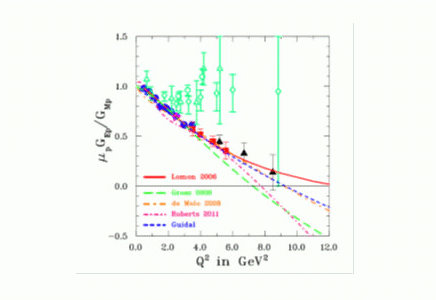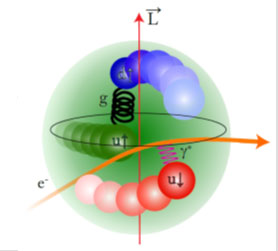The Electric and Magnetic Elastic Proton Form Factor Ratio GEp/GMp

Figure 1: The ratio GEp/GMp obtained by the recoil polarization technique (Punjabi et al. (2005) (filled blue circle), Puckett et al. (2012) (filled red squares) and Puckett et al. (2010) (filled black triangles)) compared to ratio obtained by the Rosenbluth technique (green open points). Theoretical curves from Lomon (2002), Guidal et al. (2005), de Melo et al. (2009), Gross et al. (2008), and Roberts et al. (2009), shown as solid (red), short-dashed (blue), dash-dot (orange), dash (green), and short dash-dot (magenta), respectively.
Additional Links
One of the fundamental goals of nuclear physics is to understand the structure and behavior of strongly interacting matter in terms of its basic constituents, quarks and gluons. An important step towards this goal is the characterization of the internal structure of the nucleon; the elastic electric and magnetic form factors of the proton and neutron are key ingredients of this characterization. The elastic electromagnetic form factors are directly related to the charge and current distributions inside the nucleon; these form factors are among the most basic observables of the nucleon.
The challenge of understanding the nucleon's structure and dynamics has occupied a central place in nuclear physics; many experimental and theoretical physicists have spent a considerable amount of effort in the last five decades to understand it. A break-through was made towards this goal in the last decade and a half, when two JLab Hall A experiments extracted the elastic electromagnetic form factor ratio of the proton, GEp/GMp , from the measured recoil proton polarization components, using the polarization transfer method. A third experiment in Hall C at JLab has pushed the highest Q2 limit to 8.5 GeV2 using the same method.

Figure 2: Interaction of electron with one of the quark in a proton through exchange of a virtual photon
The form factor ratio data from all three JLab recoil polarization experiments are shown in Figure 1, which display a strikingly different Q2 dependence than the Rosenbluth results. The most important feature of the data from JLab is the decrease of the ratio to Q2= 8.5 GeV2, which indicates that GEp falls faster with increasing Q2 than GMp and demonstrates that the spatial extension of charge is larger than that of magnetization. This is the first definitive experimental indication that the Q2 dependence of GEp and GMp is different. In the third experiment in Hall C, the ratio is decreasing, however with a strong indication that the linear behavior has softened toward a possible constancy of the ratio at Q2 values beyond the range covered so far.
References:
1. M. K. Jones et al., Phys. Rev. Lett. 84 (2000) 1398; V. Punjabi et al., Phys. Rev. C 71 (2005) 055202
2. O. Gayou et al., Phys. Rev. Lett. 88 (2002) 092301; A.J.R. Puckett et al., Phys. Rev. C 85 (2012) 045203
3. A.J.R. Puckett et al., Phys. Rev. Lett. 104 (2010) 242301
4. C.F. Perdrisat, V. Punjabi and M. Vanderhaeghen, Prog. Nucl. Part. Phys. 59 (2007) 694

